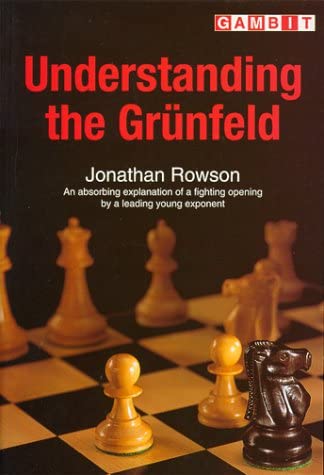Disclaimer 1: The following article contains several affiliate links to Amazon.com, meaning that if you go to Amazon and buy the recommended product (or some other product in an allotted period of time), the author of these lines will get a commission % from the purchase
Disclaimer 2: The following article is an excerpt from my article titled Best Chess Books 2022 in which I reviewed 20 chess books
Jonathan Rowson: Understanding the Grunfeld
As some of you might know, somewhere in March 2021, I decided it is finally time to ditch my beloved Modern and start playing some proper openings. When Peter Svidler released his Chessable course in April 2021, I took it as a sign from above and decided to pick the Grünfeld as my main weapon against 1.d4.
However, despite spending a large part of 2021 clicking through the course and even scoring some nice victories with Svidler’s lines in January 2022 1 I realized I still don’t fully feel the resulting Grünfeld positions and that I mix up my move orders way too often. 2 Thus, at the suggestion of my coach, I decided to pick up a Grünfeld resource that would be more oriented toward understanding. Thus, the book titled Understanding the Grünfeld, written by a renowned author and philosopher GM Jonathan Rowson (whose book Moves That Matter I rated very highly back in 2019) seemed like a very logical choice
Understanding the Grünfeld, is essentially, a Grünfeld repertoire book. Out of the total 14 chapters, approximately 11.5 have a heavy theoretical flavour. If we disregard early deviations, Londons, and Tromps, this book covers it all – from rare 3rd moves to main variations of the Grünfeld.
Alas, as expected from an opening book written in 1999 – a lot of the material presented in it is quite outdated. Many 3 lines proposed by the author are not the best from the standpoint of the modern theory – while some of them are just outright unplayable. From a purely theoretical perspective, the book simply doesn’t stand the test of time. 4
The value of this book is primarily contained in the 2.5 non-theoretical chapters – as well as parts of theoretical chapters – where the author talks about key Grünfeld ideas, motifs, and concepts such as dealing with the passed d-pawn or handling the typical Grünfeld endgames. Whereas concrete lines are constantly changing, the fundamental ideas behind any opening are very much permanent – especially if we are talking about the lower-rating levels. In these chapters/chapter fragments, the author really does try his best to help you understand the Grünfeld, as opposed to purely trying to memorize it.
Since I am also a big fan of Rowson’s introspective, evocative and elaborate writing style, it is not surprising that this book did appeal to me despite its theoretical deficiencies. Since it has a huge number of Model Games, I think there is a lot of value in playing through them and in treating it as a non-opening book.
Although I will admit it is probably not the most efficient way to go about learning the opening as complex and theoretical as Grünfeld.

